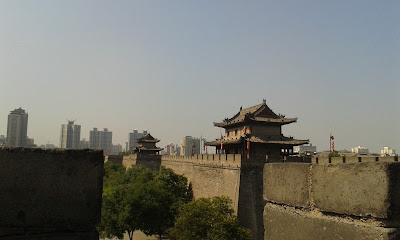On the evening after we left Shaolin, we travelled on a high-speed train to Xi’an, one of the oldest cities in China and the former Chinese capital city
and end-point of the Silk Road. The next morning
we visited the nearby Terracotta Army, which are thousands of life-size, hand-moulded warrior, horse, and chariot statues that were buried underground to protect China's first emperor, who is buried nearby, in the afterlife. The Army was discovered in 1974 by local farmers and is still being excavated today, with new warriors having recently been discovered. However, the emperor's tomb has yet to be opened.






 |
| The Terracotta Army |






That evening we took a stroll around the shopping lanes and street-stalls in the busy Muslim Quarter of the city, and went for dinner with a few other people from our group around the main bar area (after which we somehow we ended up renting a karaoke room until around three in the morning).
We brushed off the cobwebs the next morning with a group cycle around the impressive 14-km long ancient city wall that surrounds the main city centre. This wall was first constructed over 2000 years ago and is complete with large watchtowers scattered along the length of the wall. In the afternoon we took public buses to the Dayan Pagoda for a water fountain display (getting wet from the display was very welcome considering it was nearly 40 degrees C), and then headed to the airport in the evening for a flight to Guilin from where we travelled by private bus to Yangshuo.
 |
| Xi'an at night |
 |
| Xi'an city wall |
 |
| One of the watchtowers on the wall |
 |
| Aisling on her bike |
After a free day in Yangshuo (during which we did very little other than our laundry) we started our second day there with a group bike ride around the countryside. This provided great views of the huge limestone karsts that dominate the landscape, as well as giving us a peak at some rice paddies and water buffalo. After about an hour on the bikes we hopped onto some sturdy bamboo boats for a slow and relaxing trip down the Li River, all the while being powered by the sturdy rowing of a friendly local man. After the boat trip, and after another short cycle, we had lunch in the shadow of Moon Hill, which is a crescent-shaped hill a few miles outside of Yangshuo. After lunch we ascended the steep steps to the top of the hill where we were delighted to see some local women (one of which was apparently in her mid-seventies) selling cold water for overheated tourists like us.


 |
| The view from Yangshuo |
  |
| Cycling through the rice fields |
 |
| The view from the bamboo raft |


 |
| Moon Hill |
 |
| The view from the top of Moon Hill |
That evening we headed on bus to Longsheng and onto our guest house in Ping'an, a small village home to the Zhuang ethnic minority and traditional wooden houses built into the side of the nearby mountains. From there, there were spectacular views of the surrounding rice terraces, different sections of which are known by different nicknames (such as 'the moon and seven stars' and 'nine dragons and five tigers') based on their shapes as seen from the tops of the mountains. The narrow and winding stone streets (none of which seemed to be flat) of this village were shared by people and animals (including horses, donkeys, chickens, and pigs), and all the activities of the locals seemed to be done on the streets (we saw a pig being killed, butchered, and cooked on one of the streets all in the same day!). On our second full day in Ping'an we went on a 20-km hike around the nearby rice terraces and forest areas before heading back to our guest house for some local dishes and a spot of karaoke!
 |
| Sunrise over Ping'an |
 |
| The rice terraces near Ping'an |
 |
| A horse makes its way through the Ping'an streets |
 |
| Local women chat and sell fruit on the street outside our guest house in Ping'an |




No comments:
Post a Comment